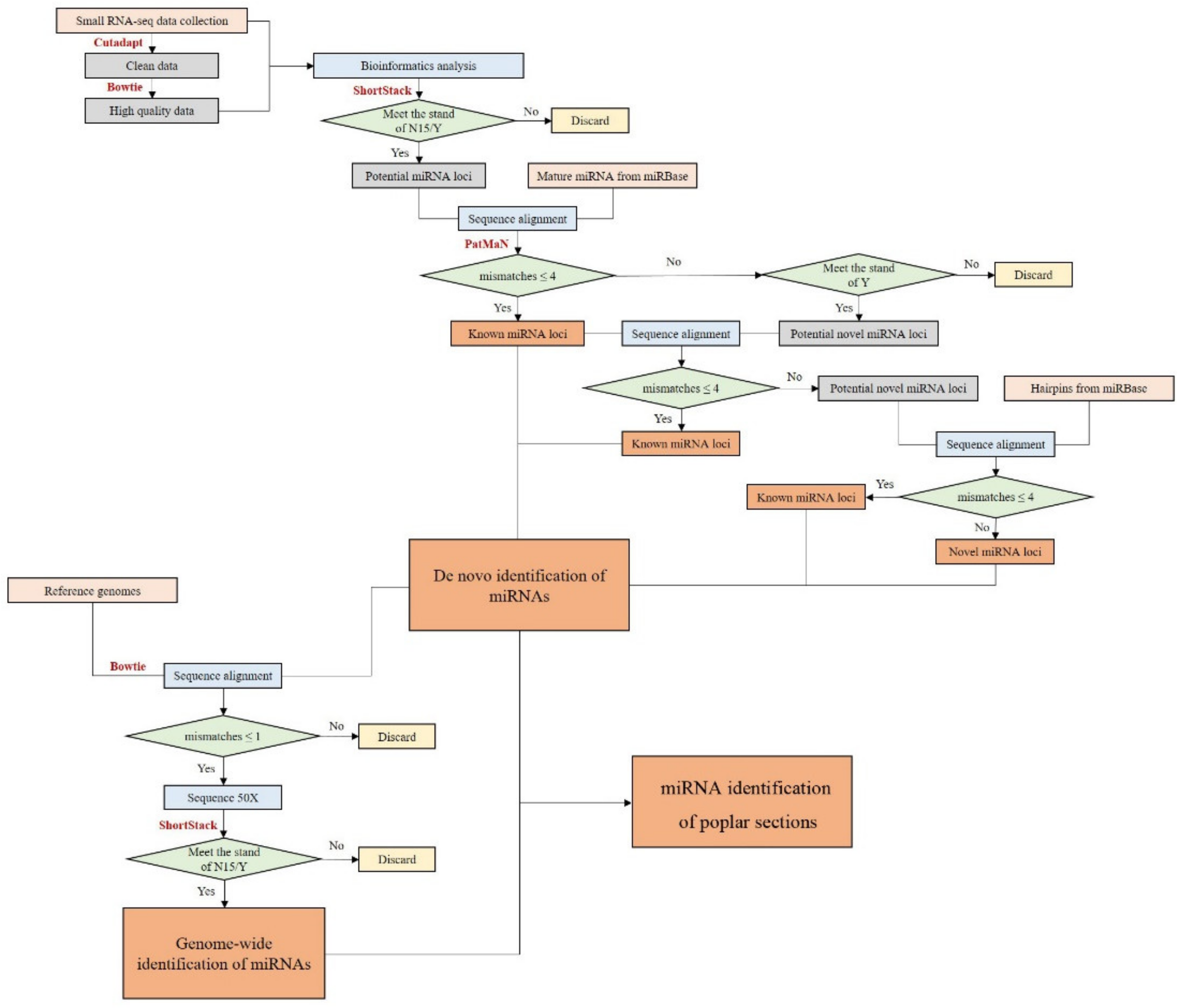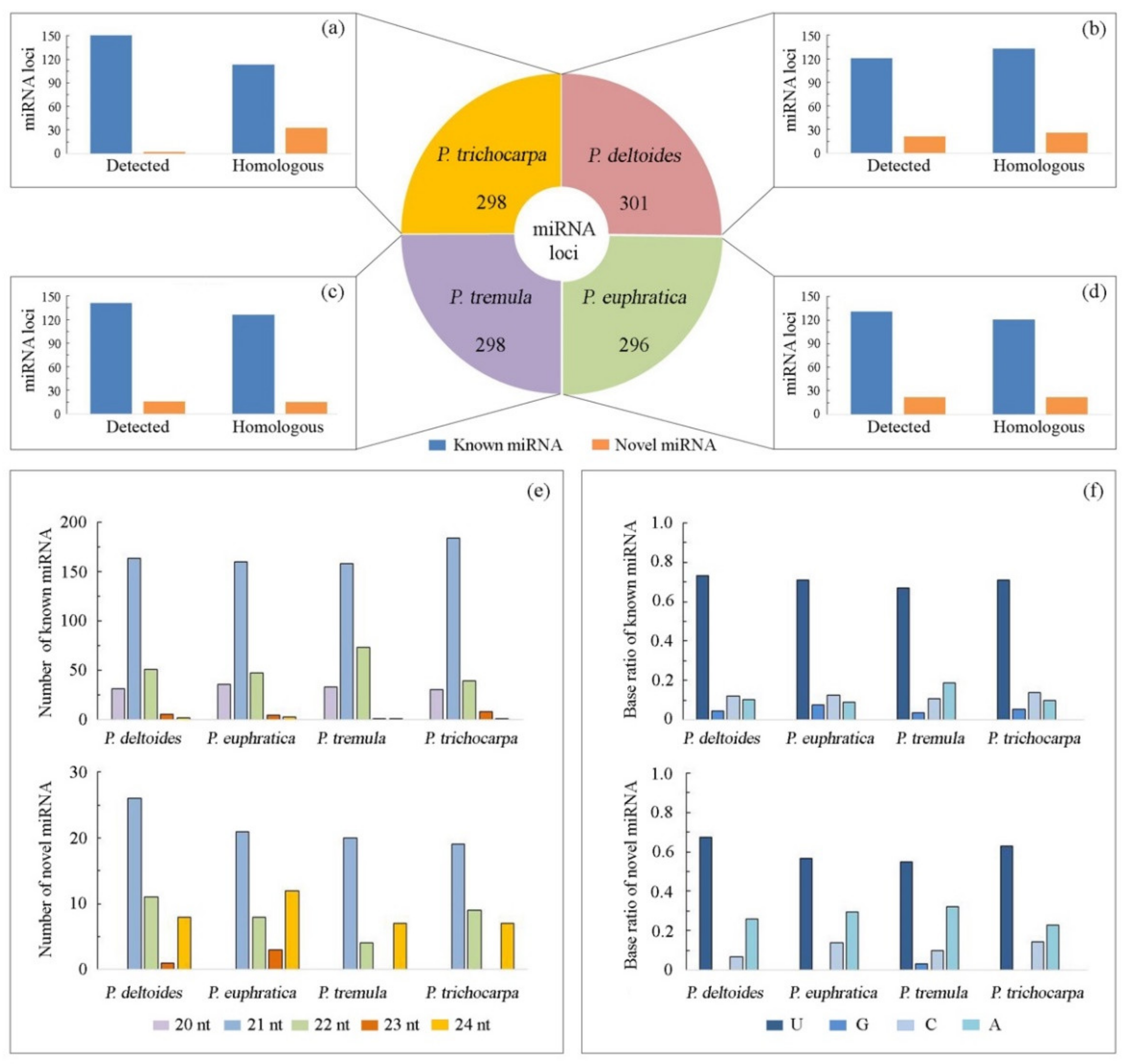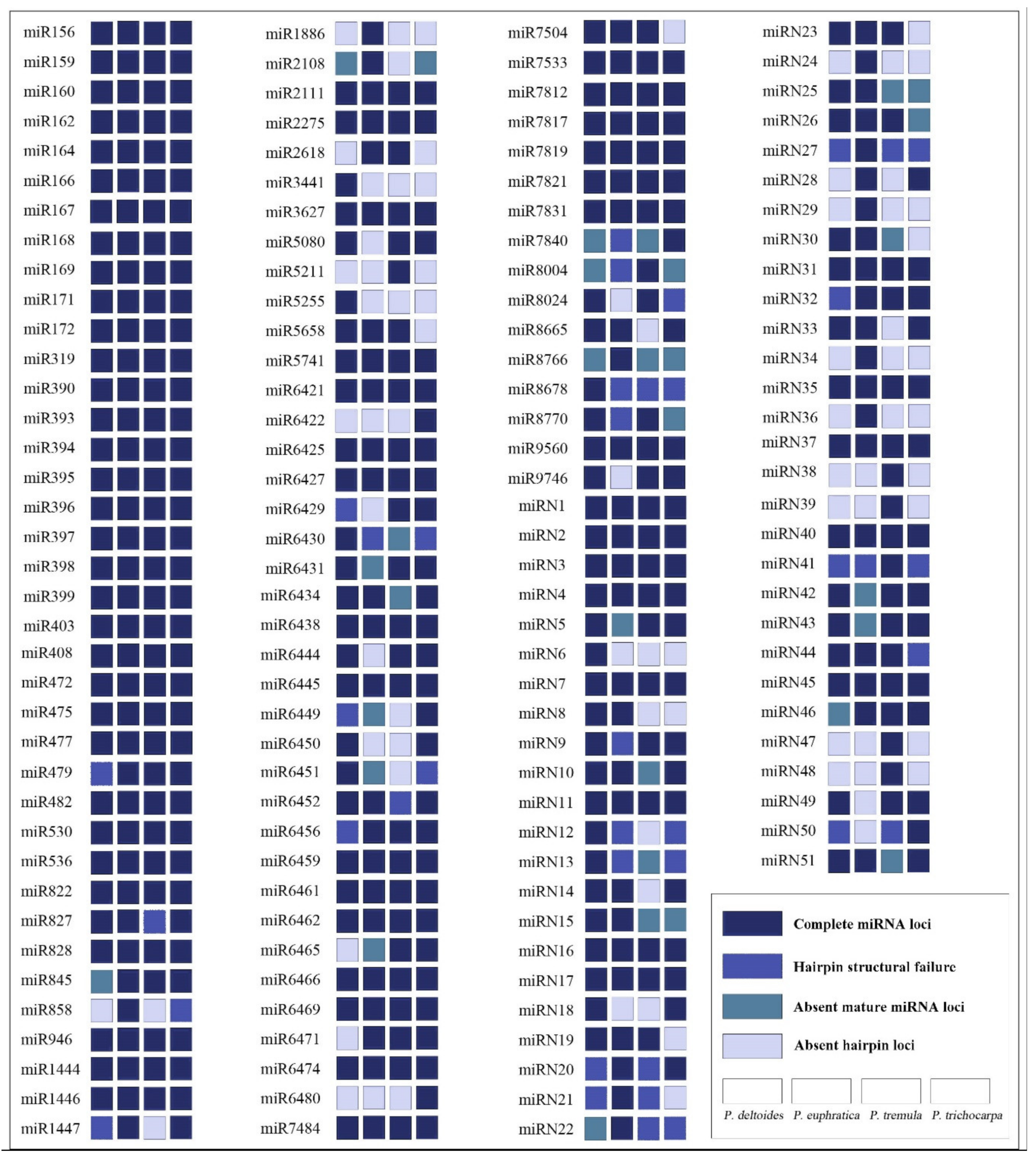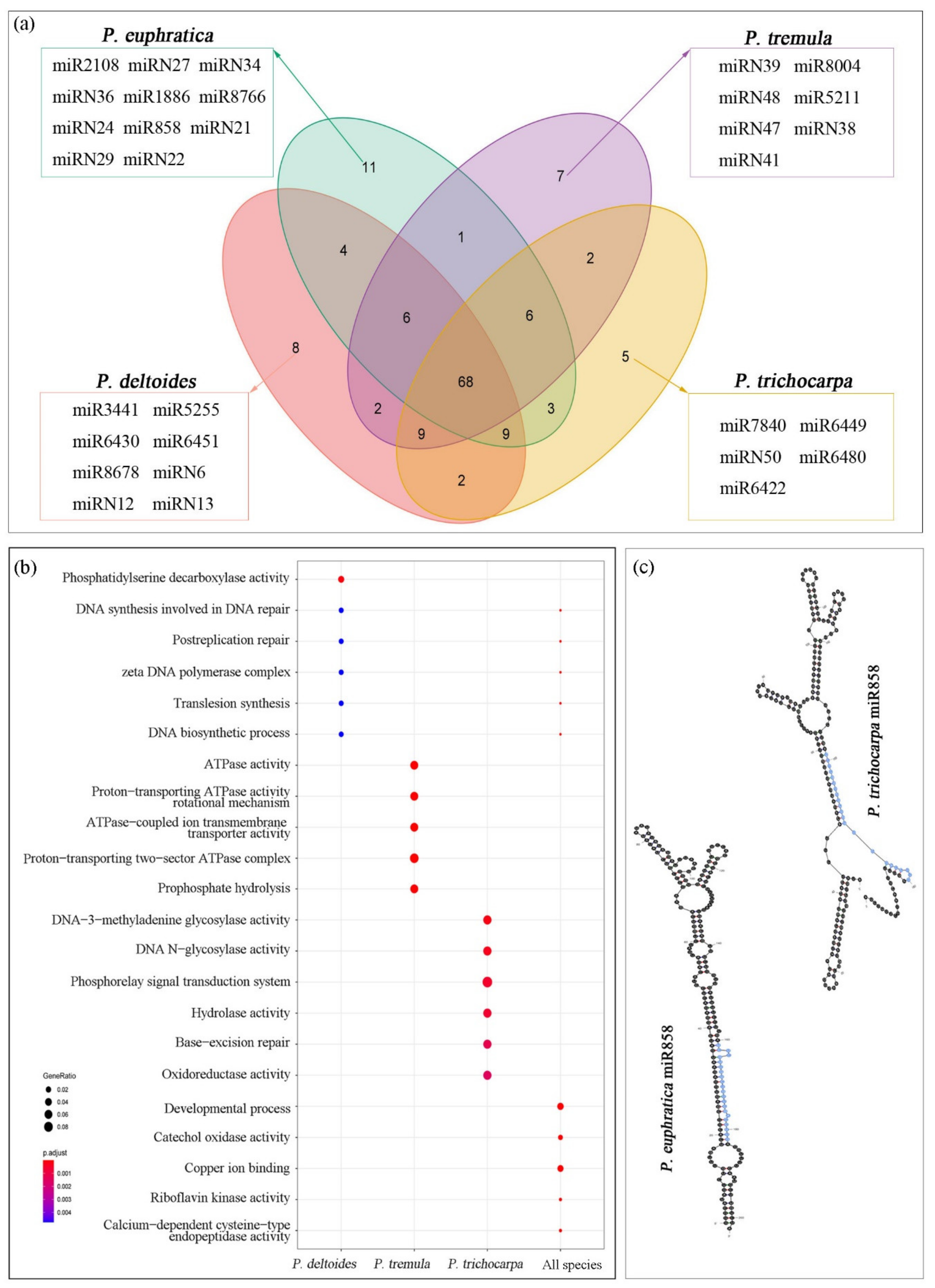Identification and Comparative Analysis of Conserved and Species-Specific microRNAs in Four Populus Sections
Abstract
:1. Introduction
2. Materials and Methods
2.1. De Novo Identification of miRNAs Using Small RNA-Seq Data
2.2. Homolog-Based Genome-Wide Identification of miRNAs
2.3. Analysis of the Conservation of miRNA Loci in Each Species
2.4. Analysis of miRNA Families among Different Species
2.5. SNP Calling
2.6. Prediction of miRNA Targets and GO Enrichment Analysis
3. Results
3.1. Identification of miRNA Loci in Each Poplar Species
3.2. Distributions of miRNAs Families in Poplar Species
3.3. Variations of miRNAs in Shared miRNA Families
3.4. Short Genomic Variants in miRNA Loci
4. Discussion
4.1. The Number of miRNA Loci Is Similar in the Four-Poplar Species
4.2. Most of the Known miRNA Families Are Shared by All Species
4.3. The Loss of the miRNA Families Caused by Variations in Pre-miRNA Hairpins
5. Conclusions
Supplementary Materials
Author Contributions
Funding
Conflicts of Interest
References
- Anne, M.R.; Nathaniel, R.S.; Rodríguez-Acosta, M. Populus trees. For. Trees 2007, 7, 1–28. [Google Scholar] [CrossRef]
- Eckenwalder, J.E. Systematics and evolution of Populus. Biol. Popul. Its Implic. Manag. Conserv. 1996, 7, 32. [Google Scholar]
- Zhang, B.; Zhu, W.; Diao, S.; Wu, X.; Lu, J.; Ding, C.J. The poplar pangenome provides insights into the evolutionary history of the genus. Commun. Biol. 2019, 2, 215. [Google Scholar] [CrossRef] [PubMed]
- Cervera, M.T.; Storme, V.; Soto, A.; Ivens, B.; Van Montagu, M.; Rajora, O.P.; Boerjan, W. Intraspecific and interspecific genetic and phylogenetic relationships in the genus Populus based on AFLP markers. Theor. Appl. Genet. 2005, 111, 1440–1456. [Google Scholar] [CrossRef] [PubMed]
- Taylor, G. Populus: Arabidopsis for forestry. Do we need a model tree? Ann. Bot. 2002, 90, 681–689. [Google Scholar] [CrossRef] [Green Version]
- Bai, S.; Wu, H.; Zhang, J.; Pan, Z.; Zhao, W.; Li, Z.; Tong, C. Genome assembly of Salicaceae Populus deltoides (Eastern Cottonwood) I-69 based on nanopore sequencing and Hi-C technologies. J. Hered. 2021, 112, 303–310. [Google Scholar] [CrossRef]
- Schiffthaler, B.; Delhomme, N.; Bernhardsson, C.; Jenkins, J.; Jansson, S.; Ingvarsson, P.; Schmutz, J.; Street, N. An improved genome assembly of the European aspen Populus tremula. Biorxiv 2019, 805614. [Google Scholar] [CrossRef] [Green Version]
- Zhang, Z.; Chen, Y.; Zhang, J.; Ma, X.; Li, Y.; Li, M.; Wang, D.; Kang, M.; Wu, H.; Yang, Y.; et al. Improved genome assembly provides new insights into genome evolution in a desert poplar (Populus euphratica). Mol. Ecol. Resour. 2020, 20, 781–794. [Google Scholar] [CrossRef]
- Chen, J.; Xie, J.; Chen, B.; Quan, M.; Li, Y.; Li, B.; Zhang, D. Genetic variations and miRNA-target interactions contribute to natural phenotypic variations in Populus. New Phytol. 2016, 212, 150–160. [Google Scholar] [CrossRef] [Green Version]
- Tuskan, G.A.; DiFazio, S.; Jansson, S.; Bohlmann, J.; Grigoriev, I.; Hellsten, U. The genome of black cottonwood, Populus trichocarpa (Torr. & Gray). Science 2006, 313, 1596–1604. [Google Scholar] [CrossRef] [Green Version]
- Evans, L.M.; Slavov, G.T.; Rodgers-Melnick, E.; Martin, J.; Ranjan, P.; Muchero, W.; Brunner, A.M.; Schackwitz, W.; Gunter, L.; Chen, J.G.; et al. Population genomics of Populus trichocarpa identifies signatures of selection and adaptive trait associations. Nat. Genet. 2014, 46, 1089–1096. [Google Scholar] [CrossRef] [Green Version]
- Dezulian, T.; Palatnik, J.F.; Huson, D.H.; Weigel, D. Conservation and divergence of microRNA families in plants. Genome Biol. 2005, 6, 1–25. [Google Scholar] [CrossRef]
- Cai, H.; Yang, C.; Liu, S.; Qi, H.; Wu, L.; Xu, L.A. MiRNA-target pairs regulate adventitious rooting in Populus: A functional role for miR167a and its target Auxin response factor 8. Tree Physiol. 2019, 39, 1922–1936. [Google Scholar] [CrossRef]
- Xie, M.; Zhang, S.; Yu, B. microRNA biogenesis, degradation and activity in plants. Cell. Mol. Life Sci. 2015, 72, 87–99. [Google Scholar] [CrossRef]
- Xu, C.; Tao, Y.; Fu, X.; Guo, L.; Xing, H.; Li, C.; Yang, Z.; Su, H.; Wang, X.; Hu, J.; et al. The microRNA476a-RFL module regulates adventitious root formation through a mitochondria-dependent pathway in Populus. New Phytol. 2021, 230, 2011–2028. [Google Scholar] [CrossRef]
- Xie, J.; Yang, X.; Song, Y.; Du, Q.; Li, Y.; Chen, J.; Zhang, D. Adaptive evolution and functional innovation of Populus-specific recently evolved microRNAs. New Phytol. 2017, 213, 206–219. [Google Scholar] [CrossRef] [Green Version]
- Li, B.; Qin, Y.; Duan, H.; Yin, W.; Xia, X. Genome-wide characterization of new and drought stress responsive microRNAs in Populus euphratica. J. Exp. Bot. 2011, 62, 3765–3779. [Google Scholar] [CrossRef] [Green Version]
- Zhou, J.; Liu, M.; Jiang, J.; Qiao, G.; Lin, S.; Li, H.; Xie, L.; Zhuo, R. Expression profile of miRNAs in Populus cathayana L. and Salix matsudana Koidz under salt stress. Mol. Biol. Rep. 2012, 39, 8645–8654. [Google Scholar] [CrossRef]
- Shuai, P.; Liang, D.; Zhang, Z.; Yin, W.; Xia, X. Identification of drought-responsive and novel Populus trichocarpa microRNAs by high-throughput sequencing and their targets using degradome analysis. BMC Genom. 2013, 14, 1–14. [Google Scholar] [CrossRef] [Green Version]
- Ambros, V.; Bartel, B.; Bartel, D.P.; Burge, C.B.; Carrington, J.C.; Chen, X.; Dreyfuss, G.; Eddy, S.R.; Griffiths-Jones, S.; Marshall, M.; et al. A uniform system for microRNA annotation. RNA 2003, 9, 277–279. [Google Scholar] [CrossRef] [Green Version]
- Taylor, R.S.; Tarver, J.E.; Foroozani, A.; Donoghue, P.C. MicroRNA annotation of plant genomes—Do it right or not at all. Bioessays 2017, 39, 1600113. [Google Scholar] [CrossRef] [PubMed]
- Taylor, R.S.; Tarver, J.E.; Hiscock, S.J.; Donoghue, P.C. Evolutionary history of plant microRNAs. Trends Plant Sci. 2014, 19, 175–182. [Google Scholar] [CrossRef] [PubMed]
- Martin, M. Cutadapt removes adapter sequences from high-throughput sequencing reads. Embnet J. 2011, 17, 10–12. [Google Scholar] [CrossRef]
- Griffiths-Jones, S.; Bateman, A.; Marshall, M.; Khanna, A.; Eddy, S.R. Rfam: An RNA family database. Nucleic Acids Res. 2003, 31, 439–441. [Google Scholar] [CrossRef] [Green Version]
- Langmead, B. Aligning short sequencing reads with Bowtie. Curr. Protoc. Bioinform. 2010, 32, 11.7.1–11.7.14. [Google Scholar] [CrossRef]
- MJ, A. ShortStack: Comprehensive annotation and quantification of small RNA genes. RNA 2013, 19, 740–751. [Google Scholar] [CrossRef] [Green Version]
- Kozomara, A.; Birgaoanu, M.; Griffiths-Jones, S. miRBase: From microRNA sequences to function. Nucleic Acids Res. 2018, 47, 155–162. [Google Scholar] [CrossRef]
- Prufer, K.; Stenzel, U.; Dannemann, M.; Green, R.E.; Lachmann, M.; Kelso, J. PatMaN: Rapid alignment of short sequences to large databases. Bioinformatics 2008, 24, 1530–1532. [Google Scholar] [CrossRef]
- Li, H.; Handsaker, B.; Wysoker, A.; Fennell, T.; Ruan, J.; Homer, N.; Marth, G.; Abecasis, G.; Durbin, R. The sequence alignment/map (SAM) format and SAMtools 1000 genome project data processing subgroup. Bioinformatics 2009, 25, 2078–2079. [Google Scholar] [CrossRef] [Green Version]
- Xue, L.; Wu, H.; Chen, Y.; Li, X.; Hou, J.; Lu, J.; Wei, S.; Dai, X.; Olson, M.S.; Liu, J.; et al. Evidences for a role of two Y-specific genes in sex determination in Populus deltoides. Nat. Commun. 2020, 11, 5893. [Google Scholar] [CrossRef]
- Quinlan, A.R.; Hall, I.M. BEDTools: A flexible suite of utilities for comparing genomic features. Bioinformatics 2010, 26, 841–842. [Google Scholar] [CrossRef] [Green Version]
- Bourgeois, Y.; Roulin, A.C.; Muller, K.; Ebert, D. SNPs Called with Freebayes. 2017. Available online: https://datadryad.org/stash/dataset/doi:10.5061/dryad.g89m1 (accessed on 20 April 2022).
- Dai, X.; Zhuang, Z.; Zhao, P.X. psRNATarget: A plant small RNA target analysis server (2017 release). Nucleic Acids Res. 2018, 46, 49–54. [Google Scholar] [CrossRef] [Green Version]
- Gene Ontology Consortium. The Gene Ontology (GO) database and informatics resource. Nucleic Acids Res. 2004, 32, 258–261. [Google Scholar] [CrossRef] [Green Version]
- Yu, G. Statistical analysis and visualization of functional profiles for genes and gene clusters. J. Integr. Biol. 2012, 16, 284–287. [Google Scholar]
- Voinnet, O. Origin, biogenesis, and activity of plant microRNAs. Cell 2009, 136, 669–687. [Google Scholar] [CrossRef] [Green Version]
- The International Wheat Genome Sequencing Consortium (IWGSC). A chromosome-based draft sequence of the hexaploid bread wheat (Triticum aestivum) genome. Science 2014, 345, 1251788. [Google Scholar] [CrossRef]
- Cuperus, J.T.; Fahlgren, N.; Carrington, J.C. Evolution and functional diversification of miRNA gene. Plant Cell 2011, 23, 431–442. [Google Scholar] [CrossRef] [Green Version]
- Barakat, A.; Wall, P.K.; Diloreto, S.; Depamphilis, C.W.; Carlson, J.E. Conservation and divergence of microRNAs in Populus. BMC Genom. 2007, 8, 1–16. [Google Scholar] [CrossRef] [Green Version]
- Li, B.; Yin, W.; Xia, X. Identification of microRNAs and their targets from Populus euphratica. Biochem. Biophys. Res. Commun. 2009, 388, 272–277. [Google Scholar] [CrossRef]
- Nozawa, M.; Miura, S.; Nei, M. Origins and evolution of microRNA genes in plant species. Genome Biol. Evol. 2012, 4, 230–239. [Google Scholar] [CrossRef] [Green Version]
- De Wit, E.; Linsen, S.E.; Cuppen, E.; Berezikov, E. Repertoire and evolution of miRNA genes in four divergent nematode species. Genome Res. 2009, 19, 2064–2074. [Google Scholar] [CrossRef] [PubMed] [Green Version]
- Gong, J.; Tong, Y.; Zhang, H.M.; Wang, K.; Hu, T.; Shan, G.; Sun, J.; Guo, A.Y. Genome-wide identification of SNPs in microRNA genes and the SNP effects on microRNA target binding and biogenesis. Hum. Mutat. 2011, 33, 254–263. [Google Scholar] [CrossRef] [PubMed]
- Rajagopalan, R.; Vaucheret, H.; Trejo, J.; Bartel, D.P. A diverse and evolutionarily fluid set of microRNAs in Arabidopsis thaliana. Genes Dev. 2006, 20, 3407–3425. [Google Scholar] [CrossRef] [PubMed] [Green Version]




| miRNA Family | Number of miRNA Sequences | Sum | Unique Sequences | miRNA Family | Number of miRNA Sequences | Sum | Unique Sequences | ||||||
|---|---|---|---|---|---|---|---|---|---|---|---|---|---|
| P. dela | P. eupb | P. trec | P. trid | P. del | P. eup | P. tre | P. tri | ||||||
| miR169 | 24 | 20 | 27 | 25 | 96 | 34 | miR7533 | 1 | 1 | 0 | 1 | 3 | 2 |
| miR399 | 7 | 9 | 9 | 11 | 36 | 12 | miRN4 | 1 | 1 | 1 | 1 | 4 | 2 |
| miR167 | 9 | 8 | 8 | 9 | 34 | 8 | miRN11 | 1 | 1 | 1 | 1 | 4 | 2 |
| miR171 | 12 | 10 | 9 | 11 | 42 | 7 | miRN17 | 1 | 1 | 1 | 1 | 4 | 2 |
| miR166 | 16 | 10 | 16 | 15 | 57 | 7 | miR6459 | 1 | 1 | 1 | 1 | 4 | 2 |
| miR172 | 3 | 7 | 6 | 7 | 23 | 7 | miR472 | 3 | 2 | 2 | 2 | 9 | 2 |
| miR396 | 7 | 6 | 6 | 7 | 26 | 6 | miR6438 | 1 | 1 | 1 | 1 | 4 | 2 |
| miR156 | 12 | 10 | 10 | 12 | 44 | 6 | miR6469 | 1 | 1 | 1 | 1 | 4 | 2 |
| miR5741 | 2 | 1 | 1 | 3 | 7 | 6 | miRN40 | 2 | 1 | 2 | 3 | 8 | 2 |
| miR160 | 7 | 10 | 6 | 8 | 31 | 5 | miR6474 | 1 | 1 | 1 | 1 | 4 | 2 |
| miR536 | 2 | 1 | 2 | 3 | 8 | 5 | miR530 | 1 | 2 | 1 | 1 | 5 | 2 |
| miR319 | 7 | 7 | 6 | 8 | 28 | 5 | miR7819 | 1 | 1 | 1 | 1 | 4 | 2 |
| miR395 | 4 | 7 | 8 | 5 | 24 | 5 | miR7821 | 1 | 1 | 1 | 1 | 4 | 2 |
| miR477 | 3 | 3 | 2 | 2 | 10 | 5 | miR822 | 1 | 1 | 1 | 1 | 4 | 2 |
| miR7817 | 3 | 0 | 3 | 2 | 8 | 5 | miRN45 | 1 | 1 | 1 | 1 | 4 | 2 |
| miR6462 | 3 | 1 | 2 | 3 | 9 | 4 | miRN37 | 1 | 1 | 1 | 1 | 4 | 2 |
| miR1446 | 4 | 6 | 2 | 4 | 16 | 4 | miRN2 | 1 | 1 | 1 | 1 | 4 | 2 |
| miR159 | 4 | 3 | 3 | 4 | 14 | 4 | miR408 | 1 | 1 | 1 | 1 | 4 | 2 |
| miR3627 | 2 | 2 | 1 | 2 | 7 | 4 | miR6427 | 2 | 1 | 1 | 1 | 5 | 1 |
| miR1444 | 2 | 2 | 2 | 2 | 8 | 4 | miR390 | 4 | 4 | 4 | 4 | 16 | 1 |
| miR482 | 4 | 4 | 4 | 4 | 16 | 4 | miR2111 | 2 | 0 | 2 | 2 | 6 | 1 |
| miR6425 | 1 | 0 | 4 | 1 | 6 | 4 | miR828 | 2 | 2 | 2 | 1 | 7 | 1 |
| miR7812 | 2 | 2 | 1 | 2 | 7 | 3 | miR7484 | 1 | 0 | 0 | 1 | 2 | 1 |
| miR397 | 2 | 1 | 3 | 2 | 8 | 3 | miRN3 | 1 | 1 | 1 | 1 | 4 | 1 |
| miR393 | 4 | 4 | 4 | 4 | 16 | 3 | miRN7 | 2 | 1 | 1 | 1 | 5 | 1 |
| miRN1 | 1 | 1 | 1 | 1 | 4 | 3 | miR168 | 2 | 2 | 2 | 2 | 8 | 1 |
| miRN16 | 7 | 2 | 1 | 4 | 14 | 3 | miRN31 | 2 | 2 | 1 | 2 | 7 | 1 |
| miR6466 | 1 | 2 | 1 | 1 | 5 | 3 | miR394 | 2 | 2 | 2 | 2 | 8 | 1 |
| miR2275 | 2 | 1 | 2 | 2 | 7 | 3 | miR7831 | 1 | 1 | 1 | 1 | 4 | 1 |
| miR403 | 3 | 3 | 3 | 3 | 12 | 2 | miR162 | 2 | 2 | 1 | 2 | 7 | 1 |
| miR164 | 4 | 5 | 6 | 5 | 20 | 2 | miR6445 | 3 | 1 | 1 | 2 | 7 | 1 |
| miR475 | 3 | 2 | 2 | 2 | 9 | 2 | miR6421 | 1 | 1 | 1 | 1 | 4 | 1 |
| miR398 | 2 | 2 | 3 | 3 | 10 | 2 | miRN35 | 1 | 1 | 1 | 1 | 4 | 1 |
| miR9560 | 1 | 1 | 1 | 1 | 4 | 2 | miR6461 | 1 | 1 | 1 | 1 | 4 | 1 |
| Species | Number of SNPs | SNP Density (nt/kb) | ||||
|---|---|---|---|---|---|---|
| Pre-miRNA Hairpins | Mature miRNA | Seed Region | Pre-miRNA Hairpins | Mature miRNA | Seed Region | |
| P. deltoides | 1020 | 90 | 29 | 23.2 | 14.07 | 16.06 |
| P. trichocarpa | 1316 | 136 | 36 | 30.84 | 21.46 | 20.07 |
Publisher’s Note: MDPI stays neutral with regard to jurisdictional claims in published maps and institutional affiliations. |
© 2022 by the authors. Licensee MDPI, Basel, Switzerland. This article is an open access article distributed under the terms and conditions of the Creative Commons Attribution (CC BY) license (https://creativecommons.org/licenses/by/4.0/).
Share and Cite
Qi, Y.-L.; Xue, L.-J.; El-Kassaby, Y.A.; Guo, Y. Identification and Comparative Analysis of Conserved and Species-Specific microRNAs in Four Populus Sections. Forests 2022, 13, 873. https://doi.org/10.3390/f13060873
Qi Y-L, Xue L-J, El-Kassaby YA, Guo Y. Identification and Comparative Analysis of Conserved and Species-Specific microRNAs in Four Populus Sections. Forests. 2022; 13(6):873. https://doi.org/10.3390/f13060873
Chicago/Turabian StyleQi, Yong-Li, Liang-Jiao Xue, Yousry A. El-Kassaby, and Ying Guo. 2022. "Identification and Comparative Analysis of Conserved and Species-Specific microRNAs in Four Populus Sections" Forests 13, no. 6: 873. https://doi.org/10.3390/f13060873





